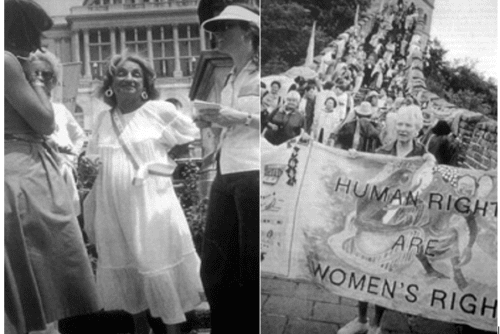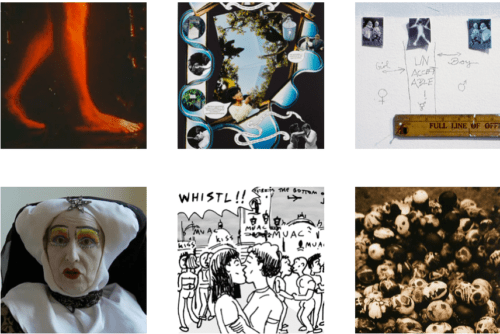The Cop in the Heart—Internalized Patriarchy
These reflections, lessons, and revolutionary guiding principles are particularly helpful for those of us who are organizing at the crossroads of oppression (on the basis of class, gender, race, sexuality, and so on). Prior to the collapse of the Soviet Union, there were many national revolutionary struggles that did achieve real change in their respective countries. However, these movements generally focused only on overthrowing capitalism and did not address the intersections of capitalism with patriarchy, racism, and other forms of oppression. Class was identified in the classic Marxist analysis as the “primary” contradiction. By the early 1970s, organizers began critiquing this model for marginalizing women, indigenous peoples, and other people from “ethnic minorities.” In addition, these older models conceptualized the struggle as happening only at the level of institutional change, either armed or traditional electoral political struggles. Struggle was not something one could participate in through one’s everyday life. Rather, true revolutionaries were supposed to leave their home, go to the mountains to be trained to join armed struggle, or work grueling political election campaigns for months away from home and family. This mode of organizing was based on a macho revolutionary standard of struggle in which commitment is measured by how “tough” you are, how much you can sacrifice family and love in order to focus on the revolutionary process. Mostly, this resulted in women being left behind to raise children on their own, many times not knowing if their partners had been murdered or if they had chosen new intimate relationships. Some women were also integrated into these struggles, but only if they “dressed like men,” acted in cold blood, left their children and families for years at a time, and followed the order of command and obey.
As economic, military, and ecological devastation continues to make life in our world ever more violent and dehumanized, there is a clear need to step up our commitment and militancy. But we must be careful not to equate patriarchal, hierarchical militarism with militancy. Some US-based organizers, including feminists of color, seem to romanticize this “old-school” revolutionary model, equating militaristic talk and dress, top-down chains of command, “tight security,” long hours at meetings every night, and personal-life sacrifice with being truly revolutionary. This is ironic because many women’s groups and queer folks, and ex-cadres and some comandantes of the revolutionary Left in Latin America have spent the past 15 years critiquing the inherently patriarchal, hierarchical, dehumanizing basis of these models of organizing.
But today it still plays out in strange ways. For example, in 2004, SIIS was part of a citywide coalition that coordinated well-organized community contingents for a series of marches against the Republican National Convention (RNC). This coalition was committed to the important work of keeping our people safe and security was stepped up. But somehow this also manifested as security marshals barking orders at people to get in single file without explanations, and as loud and hard commands to the young people holding the banner to “Hold Up the Banner!” whenever they lowered it from being tired. Security persons were not to socially interact with marchers, and talking and smiling were not allowed. When SIIS shared in the debrief session our concerns about what we felt were patriarchal practices and unnecessary levels of hierarchy, others looked at us with blank faces; most of them were other women of color.
This story is not at all meant to disrespect those organizers. Rather, it is an opportunity to think about how deeply we have internalized patriarchal dominance, even as women and queer folks. Our critique did not fully register with some people present at that meeting, in large part because we did not know how to clearly and compassionately articulate it, as we were trying to figure it out for the first time. It was only the next year, when a few of us were visiting with the Argentinean autonomous MTD Solano movement, that we learned much from listening to their reflections of how important it is that “security” people at the roadblocks not have any power over others. The political intentionality they put toward not re-creating policing relations between people was eye-opening, especially considering the high-risk conditions of their struggles—people in the past had lost their lives. Learning from these practices and comparing them to our relatively small and peaceful RNC protests was an important lesson.
Many powerful voices have spoken of these conflicts and contradictions of the revolutionary Left. One example comes from the 1979 film by Pastor Vega, Retrato de Teresa (Portrait of Teresa), which documents how many women in postrevolutionary Cuba did not end up with easier lives, but, rather, with a triple workload: the work of earning a living, the work of participating in revolutionary politics/culture, and the work of taking care of children and the home. Similarly, Lorena Pena, better known as Comandante Rebeca of the FPL (Fuerzas Populares de Liberación) in El Salvador, has pointed to her organization’s lack of understanding of the extra burdens carried by the women and mothers who are militants and combatants. She shares her own experience of having had to part with her 8-month-old child in order to fulfill her responsibilities as a clandestine organizer working in the tugurios (shantytowns): “Separating from a child is like having your arm amputated. I cannot explain the sensation even physically that one feels…. I remember that to give myself strength I even read some writings of Lenin aimed at women where he speaks of motherhood in the historical-social sense.”1 Rebeca also critiques her organization’s policies toward women combatants who become pregnant; they are subsequently demoted regardless of their technical and political skill level. While she recognizes the need for pregnant women to take on a role with less physical strain, she argues that this should not mean being placed in roles of less political value and recognition within the organization. These experiences eventually led Rebeca to help create the movimiento de mujeres (women’s movement) Melida Anaya Montes, which began within the FPL and later became an autonomous organization in order to more powerfully challenge the patriarchal, discriminatory practices and culture of political organizations in El Salvador.
One of the most confrontational and beautiful voices belongs to Pedro Lemebel, a gay communist from Chile. In his poem “Punto de Vista Diferente” (A different point of view), Lemebel directly addresses—and critiques—the “revolutionary” Left parties of Latin America with a radical vision of his own.
But don’t talk to me about the proletariat
Because being poor and gay is worse…
What will you do with us “compañeros”?
Will you tie us up by our braids Destined for a Cuban “sidario”2
Will you put us on a train to nowhere…
Are you afraid of the homosexualization of life?
And I’m not talking about sticking it in and pulling it out
I’m talking about tenderness “compañero”
I’m not going to change for Marxism
That rejected me so many times
I don’t need to change, I’m more subversive than you.
Still active in the autonomous Chilean Left, Lemebel has found a way as a writer and radio/television personality to make his experience and politics accessible to ordinary Chileans, including older working-class women like his mother and my grandmother. He speaks of everyday struggles of everyday folks as political, reaching many more people than the official Left parties ever could. Like Lemebel, many activists realize that this hierarchical and male-dominated model of being a revolutionary ultimately fails to address the concrete experiences of oppression in everyday life. Committed to building movements that are sustainable in the long term, increasingly activists are focused on creating struggle within the context of one’s life. The battleground of the struggle is in how we live, how we survive, and how we sustain our lives. Instead of bringing people to a political world, argues Gerardo Rénique, this model grounds the political in everyday life:
Confronted by the retrenchment of the state from its most basic social duties, many popular movements organize to address such aspects of everyday life as housing, nutrition, childcare, education, and productive work. One thinks here of the communal kitchens in Peru, squatter organizations in Uruguay, cooperatives of unemployed workers in Argentina, landless peasants in Brasil, and the autonomous municipalities and Juntas de Buen Gobierno (good government councils) in the territories in Mexico controlled by the EZLN. Driven by principles of solidarity, self-respect, collective participation, and communal interest, these popular institutions constitute a powerful challenge to the individualism, self-interest, and exclusion that are the core values of neoliberalism.3
In these new movements, much of the political work happens close to home. It’s not that mass demonstrations are no longer considered useful. But there is a growing understanding that such tactics, once required on a regular basis to demonstrate your political commitment, are largely, if not entirely, alien to the reality of most people’s lives, especially poor people struggling just to survive. When collectively reimagined by movement members, however, mass demonstrations can take on a new and differently gendered character. For the Zapatistas, as Javier Elorriaga, one of the EZLN’s main public figures explains,
it’s necessary to build from below, to be constantly consulting; to be looking for new forms of participation, for those who have time [to] participate and those who don’t have time; the woman who has children and has, in addition, another job and comes home to feed them; even the mother who can’t attend the assemblies, that she, too, have the possibility to participate politically. And all of this on the margins of power.4
In other words: What if, as a tired, overworked, and underpaid or unpaid woman I do not have to add going to this march to my list of things to do? What if, instead, I could integrate my political participation into my daily life? What if there were a “space” where I could build and learn politically with others, a space I could go to that was part of how I take care of myself and others? Here again, the Zapatistas’ caracoles offer us another visionary model that extends beyond mere protest or demonstration to a long-term and integrative approach to resistance.
It has taken me a long time to truly understand how to apply this theory to my lived experience as a social justice activist. Until recently, I was a full-time organizer type, single with no dependents, who received a paycheck from a non-profit for part-time work (while also teaching self-defense part-time). That non-profit is Sista II Sista, an organization I’ve been a part of for ten years. For almost the first four years of its life, SIIS was run as a volunteer collective; this all changed in 2000, when we incorporated as a non-profit with paid staff and foundation funders.5 Ultimately, financial crisis, as well as the reflections of paid and unpaid collective members, led us to decide to return to our roots as a volunteer grassroots organization. This difficult transition, in addition to my becoming a first-time mother, showed me how challenging yet important it is to participate politically. In my view, living a full, difficult, and complicated life, like all the folks we are organizing with, while also being a caretaker for an individual and/or a volunteer for an organization is the political task at hand.
If our commitment to organizing is to build with those who are most marginalized, if we want to prioritize poor and working-class women of color in the US, most of whom are responsible for the care and survival of children and/or other family members, then it is essential that we look for alternative models to movement building. We must also recognize another major challenge observed from outside the US: the dismantling of “community,” social connections, and relationships of solidarity and love. If we are faced with these conditions, it seems crucial that we try forms of organizing that center the daily experiences of those caught in the crossfire of all forms of oppression. From Latin America, we can draw from the examples of the gigantic efforts for daily survival by the oppressed, an effort that involves strengthening the communitarian spaces and ties they are constructing and re-creating every day. It is not enough to center poor and working-class women and queer folks of color’s experiences in our organizing if the mode of organizing is still very similar to male-dominated labor or US-style community organizing. In this model, only those who have the privilege and/or obligation of being full-time organizers–because they are single without dependents, or fathers who do very little parenting, or people who can afford to pay others to do the caretaking of their families–can actively participate, let alone lead our movements. Ultimately, political involvement that comes at the expense of our relationships with loved ones and the larger community is not truly liberators.6
As the material conditions worsen in the US, it is ever more clear that many people’s lives in this country are becoming as precarious as those of the peoples of the Global South, as we have seen with the impact of Hurricane Katrina on the Gulf Coast. Especially during these times, I encourage US activists to keep thinking outside the non-profit box and learn from movements, both past and present, wherever they may be, that have been able to achieve much more by working outside this narrow, even compromising structure. While the contexts are not the same, the principles of the movements in Latin America and elsewhere can help inform our organizing work here. Because they come from people who are not living in the “brain of the monster,” the US empire, they can help us identify the cops in our heads and hearts, release us from the US-centric tunnel vision, and expand our dreams of possibility.
Acknowledgments
As this is the first time that I have written an article alone (not as a collective process), I feel it is my responsibility to include some of the names of those with whom I have developed these reflections in practice over the last ten years in New York City. The collectives of Sista II Sista, Pachamama, Community Birthing Project, Sisterfire, Center for Immigrant Families, NYC Childcare Collective, Sistas on the Rise, Harm Free Zone, Refugio, INCITE! and Lola’s informal childcare crew have been working hard to embody and support these alternative revolutionary visions. Along with all those amazing compañer@s, I have had the incredibly valuable experience of being able to learn, organize, cry, and struggle closely with Nicole, Adjoa, and Ije, powerful mothers or caretakers of family. All of these folks along with my closest familia, my mother, Ximena, my grandmother Dolores, my mentor Eugenia, as well as my compañero Eric and my daughter, Xue-Li Dolores, have lovingly taught me more than I could have learned in ten more years of radical organizing as a single “organizer” with no dependents.
- Marta Harnecker, Retos de la Mujer Dirigente 2 [includes an intervew with Comandante Rebeca] (Havana, Cuba: Colección Letra Viva, MEPLA, 1993), 2. [↩]
- Sidario is a Cuban quarantine for people living with HIV. [↩]
- Rénique, “Introduction, Latin America Today,” 1. [↩]
- Javier Elorriaga, interview, Viento Sur 35 (December 1997): 24. My translation. [↩]
- For a fuller history of SIIS’s journey through the non-profit system and beyond, see “On Our Own Terms: Ten Years of Radical Community Building With Sista II Sista,” which appears in this volume [The Revolution Will Not Be Funded]. [↩]
- One project I am currently involved in was inspired by colectivos de mujeres (women’s collectives) from different Latin American movements, such as the Sandinista struggle in Nicaragua. Prior to the revolution, much work was done through day care centers clandestinely developed by the Sandinistas. No one realized they were revolutionary institutions that provided women and children with an opportunity in their everyday lives to meet for political education, organizing, and mobilizing. We are currently developing a childcare cooperative in Brooklyn, Pachamama, that is attempting to be financially self-sustaining through barter and slidingscale fees. We opened our first Pachamama cooperative in April 2005 and it has inspired some of the members to break off and begin a separate similar cooperative, Little Maroons, launched in September 2005. We are also connecting with two other working-class women-of-color groups interested in starting similar projects. In our vision these spaces can become a base for doing grassroots political education and organizing work that fits in with the lives of poor women of color in Brooklyn. Is this as a legitimate location from where to organize and participate in movement building? I hope so. [↩]




